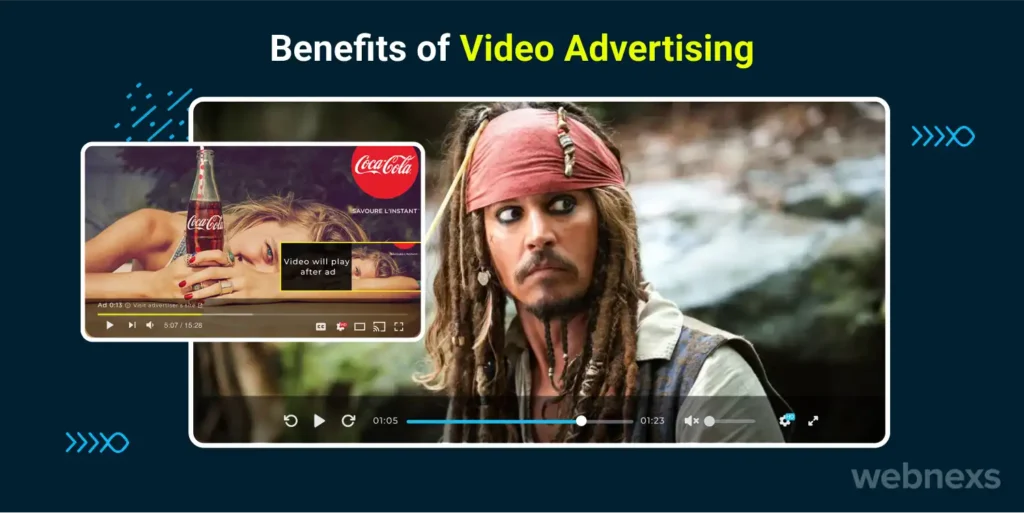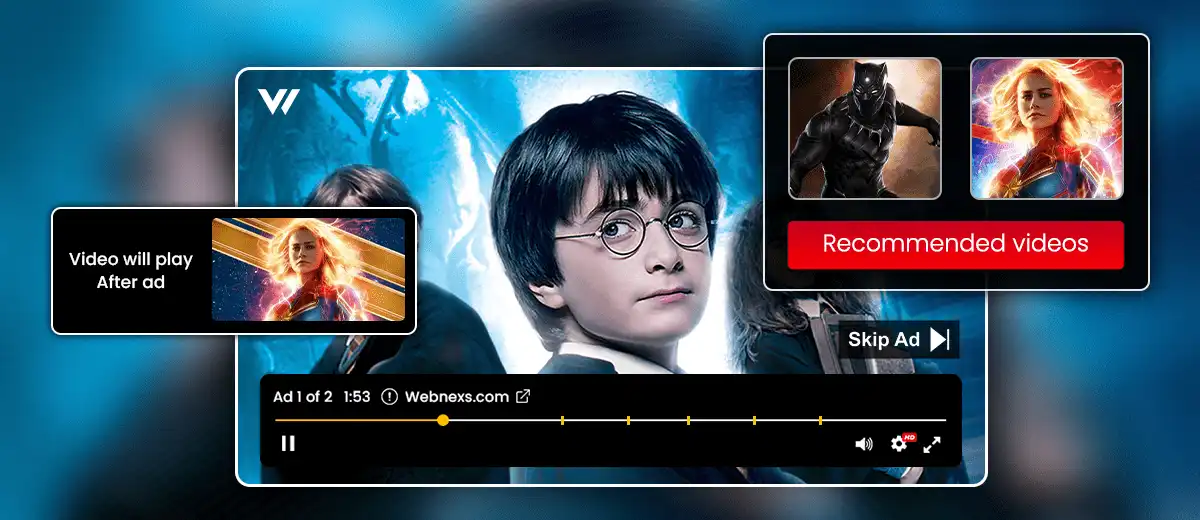Video advertising now plays a major role in digital marketing. With advanced technology and people’s quick attention, businesses are using video ads to grab their audience’s attention. However many people still don’t fully understand what video advertising is or how these ads actually reach viewers.
“Video advertising is 1200% more effective than other types of ads, such as print and social media combined, in terms of user engagement and conversion rates, These ads can increase conversion rates by up to 80%, making them a powerful tool for driving sales and other desired actions”.
This blog is about what video advertising is, the benefits it offers, and how the ads are delivered to viewers.
State Of Video Advertising
This type of advertising continues to be a popular and effective method for engaging consumers. In fact, a majority of consumers (54%) express a desire for video marketing statistics from businesses and brands they purchase from. However, there is a flip side to this trend. According to a survey, 67% of respondents find video ads with sound to be the most annoying advertising format. Despite this, marketers consistently report positive results from video ads, with 89% stating that they achieve a good return on investment (ROI) from their ad campaigns.
These statistics highlight the importance for marketers to carefully create ads that are genuinely valuable and relevant to their target audience. Additionally, the placement of ads plays a crucial role, as the goal is to make the advertising content as minimally disruptive as possible. When an ad appears at a natural break in programming, such as before a presenter discusses a new topic, viewers may be more willing to pay attention.
To strike this delicate balance, marketers are increasingly utilizing advanced ad solutions, such as Outbrain Smartads, to enhance viewer engagement. For instance, Clip Smartads employ short-form video animation to capture the viewer’s attention and encourage them to engage and convert. This approach stands in stark contrast to the intrusive and bothersome nature of pre-roll videos, resulting in higher completion rates. To see how Loreal achieved success with Clip Smartads, take a look at their case study.
By leveraging these innovative solutions, marketers can optimize their video advertising strategies and deliver a more enjoyable and impactful experience for their audience.
What is Video Advertising:
Video advertising refers to the practice of promoting products, services, or brands through video content. These ads are typically displayed before, during, or after online content, such as streaming videos, social media videos, or video-on-demand platforms. It supports the power of sight, sound, and motion to deliver impactful messages to viewers and engage them on an emotional level.
The benefits of video advertising have been significant, with the rise of online platforms providing new opportunities for businesses to reach their target audience. Today, video ads can be served across a wide range of digital channels, including social media platforms, websites, mobile applications, and video-sharing platforms like YouTube.
Best 5 Key Benefits of Video Advertising:

The benefits of Video advertising are that businesses seek to enhance their marketing efforts. Here are some key advantages:
1. Enhanced Engagement:
Video ads have the ability to captivate and engage viewers more effectively than other forms of advertising. The combination of visuals, audio, and storytelling enables businesses to create immersive experiences that resonate with their target audience.
2. Increased Brand Awareness:
By leveraging the power of video, businesses can significantly boost brand awareness. Engaging and memorable ads have a higher chance of being shared and discussed by viewers, leading to increased exposure and reach.
3. Higher Conversion Rates:
These ads have been shown to drive higher conversion rates compared to other advertising formats. The dynamic nature of video content enables businesses to showcase their products or services in action, helping potential customers visualize the benefits and make informed purchase decisions.
4. Emotional Connection:
Videos can convey emotions more effectively, helping to build a stronger connection with the audience. This emotional engagement can enhance brand loyalty. When people feel more relatable to the content, the likelihood of purchasing is higher.
5. Adaptability for Mobile Users:
With the increase in mobile device usage, video content is easily consumed on smartphones and tablets, making it accessible to a wider audience. Because the majority of people prefer mobile over other devices to spend time on social media.
Types of Video Ads:
Video advertising (ads) come in various formats and styles, each serving a unique purpose in conveying the marketing message. Some common types of video ads include:
Pre-Roll Ads:
These ads appear before the main content and typically have a duration of 15 to 30 seconds. Pre-roll ads can be skippable or non-skippable, offering businesses an opportunity to capture the viewer’s attention right at the beginning.
Mid-Roll Ads:
These ads are inserted in the middle of the video content, interrupting the viewing experience. Mid-roll ads are commonly found in longer format, such as TV show episodes or online series.
Outstream Ads:
Also known as in-read or native video ads, outstream ads are designed to fit seamlessly within written content. These ads automatically play when they come into view while scrolling through articles or web pages.
Bumper Ads:
Bumper ads are short, non-skippable video ads that are typically 6 seconds or less in duration. They are designed to convey a concise message and create brand awareness within a brief timeframe.
Overlay Ads:
Overlay ads are displayed as a semi-transparent layer on top of the ad content. They usually appear at the bottom or top of the video and can include text, images, or clickable calls to action.
Companion Ads:
Companion ads are displayed alongside the video content and provide additional information or complementary messaging. They can appear as banners, text ads, or interactive elements, reinforcing the main ad’s message.
In-Stream Ads:
In-stream ads are inserted within the video player itself and are commonly seen on platforms like YouTube. These ads can be skippable or non-skippable and appear at natural breaks in the content.
Social Media Video Ads:
Social media platforms like Facebook, Instagram, and Twitter offer opportunities for businesses to showcase ads to their target audience. These ads can be in-feed, Stories, or promoted video content.
Interactive Video Ads:
The benefits of video advertising allow interactive viewers to engage with the content by interacting with clickable elements, making choices, or exploring additional information. This type of ad encourages active participation and increases engagement.
These are just a few examples of the diverse range of video ad formats available to businesses. Choosing the right format depends on factors such as the target audience, marketing goals, and the platform or channel where the ad will be served.
Video Advertising Trends
Here are four current trends in digital advertising that marketers should focus on:
Customizing ad lengths for different channels:
Gone are the days of standard ad lengths. Different platforms and channels have varying preferences when it comes to ad durations. While shorter ads, such as six-second ones, gained popularity on platforms like YouTube, the rise of platforms like TikTok has led to the emergence of very short ads. Additionally, longer-form ads ranging from 2 to 5 minutes are becoming popular for B2B marketing. Marketers should consider the specific goals of their ads and tailor the length accordingly.
Mobile video consumption is preferred by viewers:
With the increasing use of mobile devices, viewers are gravitating towards mobile for their brand interactions and content consumption. Studies show that a majority of viewers, around 62%, prefer watching content on mobile devices or tablets. Marketers should prioritize mobile optimization when creating ads, as mobile video ads are projected to dominate the online landscape in the near future.
Video’s growing importance in sales and marketing:
This content has become increasingly important in the sales and marketing space. A significant number of sales and marketing professionals, 82%, believe that video content is more crucial than ever. Consequently, companies are producing more content, with nearly half of them creating over 51 videos per year. Marketers need to recognize the significance of video in their advertising strategies to remain competitive and keep up with industry trends.
Rise in in-house video content production:
As ad creation tools become more accessible and affordable, many companies, especially small and medium businesses, are producing video content in-house. With just a smartphone and a creative idea, marketers can create engaging video ads that yield great results. In fact, 58% of small businesses rely on internal resources to produce most or all of their content. This trend enables companies to save costs while maintaining control over their production process.
How to Create an Effective Video Advertising for Your Business
Understanding Your Target Audience:
When creating an ad, it’s crucial to have a deep understanding of your target audience. Knowing who they are, what they like, and what problems they face will help you tailor your message and visuals to resonate with them effectively. Conduct thorough market research, gather demographic information, and analyze customer feedback to develop a comprehensive understanding of your target audience.
Defining Your Goals and Objectives:
Before diving into the video creation process, clearly define your goals and objectives for the ad. Are you looking to drive sales, increase brand awareness, or promote a specific product or service? By setting clear objectives, you can align your video ad with your overall marketing strategy and measure its success accurately.
Crafting a Compelling Storyline:
A compelling storyline is the backbone of any successful advertising. Capture your audience’s attention from the start and maintain their interest throughout the ad. Use a captivating narrative, visual storytelling techniques, and an emotional appeal to keep viewers engaged and connected to your brand.
Keeping it Short and Attention-Grabbing:
In today’s fast-paced world, people have limited attention spans. Keep your ad concise and to the point. Aim for a length of 30 to 60 seconds, focusing on delivering your message quickly and effectively. Grab your audience’s attention within the first few seconds to ensure they stay engaged until the end.
Showcasing Your Product or Service:
One of the primary purposes of advertising is to showcase your product or service. Highlight its unique features, benefits, and how it solves a problem for your target audience. Use high-quality visuals, demonstrations, and testimonials to convey the value and effectiveness of your product or service. This is your opportunity to demonstrate why your offering stands out from the competition and why viewers should choose your brand.
Incorporating Branding Elements:
Consistency is key when it comes to branding. Ensure that your ad aligns with your brand’s identity by incorporating consistent colors, fonts, and visual elements. Use your logo strategically throughout the ad to reinforce brand recognition and familiarity. This will help viewers associate the ad with your business and increase brand recall.
Leveraging Emotions to Connect with Your Audience:
Emotional connections play a vital role in capturing the hearts and minds of your audience. Tap into their emotions by creating a video ad that evokes happiness, inspiration, or even empathy. Craft a compelling narrative that resonates with viewers on a personal level and establishes an emotional bond between them and your brand.
Optimizing for Mobile Viewing:
With the increasing use of mobile devices, it’s crucial to optimize your ad for mobile viewing. Ensure that your ad is visually appealing and easy to consume on smaller screens. Use large, clear text, and minimize any unnecessary elements that may hinder the viewing experience. By optimizing for mobile, you can reach a wider audience and maximize engagement.
Including a Clear call to action:
Every ad should have a clear call-to-action (CTA) that tells viewers what they should do next. Whether it’s visiting your website, making a purchase, or subscribing to your channel, guide your audience toward the desired action. Place the CTA prominently within the ad and make it compelling and enticing.
Testing and Analyzing Performance:
After creating your video ad, it’s crucial to test its performance and analyze the results. A/B testing can help you determine which variations of the ad resonate better with your audience. Pay attention to metrics like view counts, click-through rates, and conversions to gauge the ad’s effectiveness. Use these insights to make informed decisions and optimize future ad campaigns.


